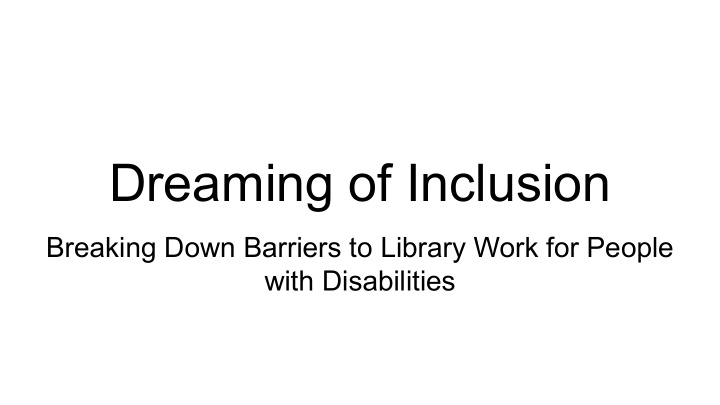



Dreaming of Inclusion Breaking Down Barriers to Library Work for People with Disabilities
Overview ● Workplace barriers for people with disabilities ● Ways to provide support ● Workplace accommodation
Question 1: Which of these have a disability?
Myth: Disability = Visible ● Many types of disability are visible ● Many types of disability are invisible ● Invisible disability often seen as less ‘legitimate’
Question 2 How many of you have people with disabilities employed in your workplace?
Myth: Disability Is Uncommon ● 1 in 7 or 4.4 million people ● 10% of university grads ● Discomfort disclosing ● May have people and not realize ● If not, why?
Question 3 How inclusive of disability is your workplace?
Myth: We are Inclusive ● Changes with AODA legislation ● Survey: big gap in perception ● Non-disabled feel workplace is more inclusive than those with disabilities ● Why is this?
Workplaces Favour the Able-Bodied ● Default assumption: people are able-bodied ● Non-disabled = ‘normal’ ● Ableism ● Workplace assumptions reflect this ● Barriers to hiring and participation
Physical Barriers ● Differ by disability ● Examples: ○ Elevators ○ Bathrooms ○ Chairs ○ Background noise
Inflexible Work Expectations ● How things need to be done ● Often alternatives ● Think about goal not how to get there ● Example: travel
Attitudes to Disability ● Able-bodied as ‘normal’ ● Disability as less than ‘normal’, negative ● Stereotypes: ○ Less productive, effective ○ Taking advantage of the system ○ Asking for special treatment ● Need to examine biases
Supporting Co-workers and Employees ● Different Categories of Disabilities ○ Their challenges ● Strategies for Support ○ For everyone and for managers
Categories of Disabilities ● Visible vs Invisible ○ Visible - A disability one notices just by looking ○ Invisible - Disability not obvious just by looking ● Lifelong vs Acquired ○ Lifelong - A disability that the person was born with ○ Acquired - A disability acquired at some point in the person’s life
Categories of Disabilities ● These can overlap: ● Physical - A limitation on a person’s physical functioning such as mobility, dexterity, stamina ● Sensory - Disability of the senses such as hearing or vision ● Intellectual - Characterized by significant limitations to intellectual functioning and adaptive behaviour ● Learning - Difficulty correctly receiving, processing and/or responding to information with average or above average intelligence
Categories of Disabilities These can overlap: ● Mental illness - recognized, medically diagnosable illness resulting in impairment of person’s cognitive, affective, or relational abilities ● Chronic pain - persistent pain, usually lasting or recurring longer than 3-6 months ● Chronic illness - medical illness that lasts a year+, requires ongoing medical attention and/or limits activities of daily living ***Other marginalized identities may overlap with disabilities causing more challenges (ex. racism and ableism)
Strategies for Support - Everyone ● Learn about different disabilities and the challenges they face ○ “What Life is Really Like for Disabled People,” The Guardian, Nov. 15, 2017 ○ “Spikes and Other Ways Disabled People Combat Touching,” BBC News, Oct. 15, 2019 ○ “Legally Blind Man Denied What He Says He Needed to Write Exam,’ CBC News, Nov. 1, 2019
Strategies for Support - Everyone ASK THE PERSON (ATP) ● Language ● Assistance ● Assumptions
Strategies for Support - Managers No matter where you are in the organization, be a leader, show that accessibility and inclusion is important ● Accessibility as high priority ● Potential training opportunities ● Cultivate culture of trust
Strategies for Support - Managers What support can look like ● Check in ● Be flexible ● Spouses/parents/family members
Accommodations ● The duty to accommodate ● Bona fide occupational requirements ● Undue hardship ● Librarians accommodate
The duty to accommodate - a high bar ● 1999: BC v. BCGEU - Meiorin case ● Supreme Court established a standard for accommodations ● The bar is higher than most people realize
Bona fide occupational requirements ● Occupational requirements must be “bona fide” ● must be rationally connected to a legitimate work-related purpose ● no clear definition or test ● courts and human rights tribunals tend to say that for an occupational requirement to be bona fide, it must be a core duty that gets to the heart of what the position is
Bona fide occupational requirements - case study Page ● shelving books (bona fide) ● driver's license (extremely unlikely to be bona fide; can be accommodated) ● physical strength / dexterity (could be bona fide; can be accommodated)
Undue hardship Criteria contributing to undue hardship ● health and safety concerns ● financial costs "so substantial that they would alter the essential nature of the enterprise, or so significant that they would substantially affect its viability"
Things that are not undue hardship ● Inconvenience ● employee morale ● third-party preferences ● costs that aren't prohibitive
Librarians accommodate already Accommodations require: ● listening ● creativity ● collaboration ● meeting people's needs ● celebrating people for what they can do These are the things librarians already do best!
Questions? George Hawtin Joanne Oud joud@wlu.ca Virginia Sytsma
Recommend
More recommend